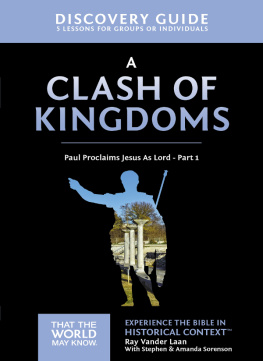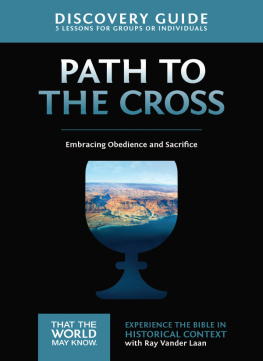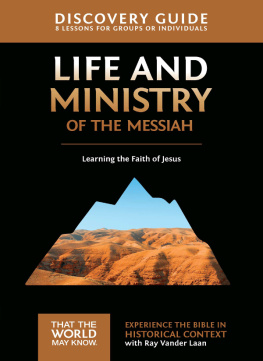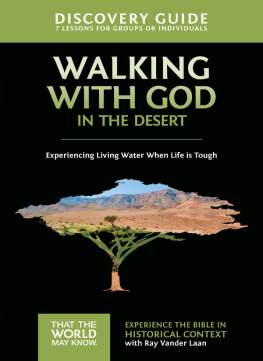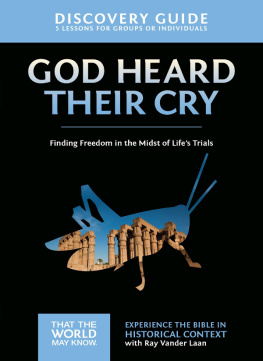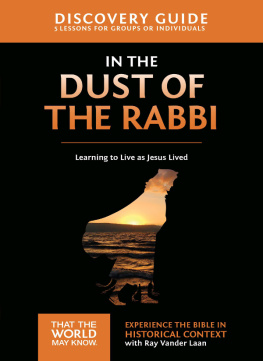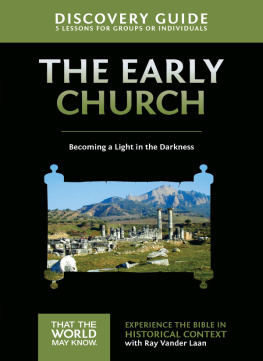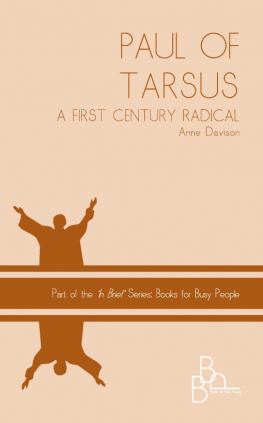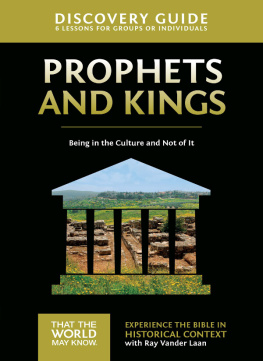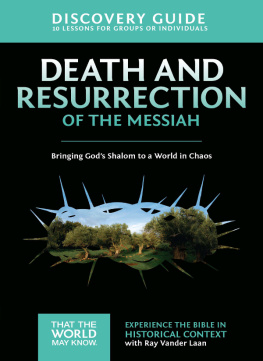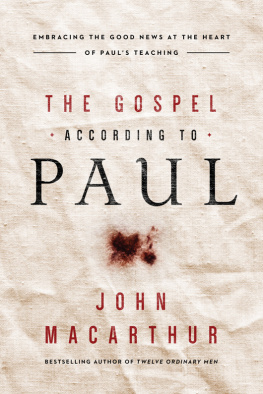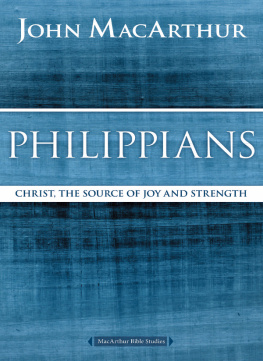ZONDERVAN
A Clash of Kingdoms Discovery Guide
Copyright 2017 by Ray Vander Laan
Requests for information should be addressed to:
Zondervan, 3900 Sparks Dr. SE, Grand Rapids, Michigan 49546
Focus on the Family and the accompanying logo and design are federally registered trademarks of Focus on the Family, 8605 Explorer Drive, Colorado Springs, Colorado 80920.
That the World May Know and Faith Lessons are trademarks of Focus on the Family.
ePub Edition May 2017: ISBN 978-0-310-08574-4
All maps created by International Mapping.
All photos and artwork are courtesy of Ray Vander Laan, Paul Murphy, and Grooters Productions.
All Scripture quotations, unless otherwise indicated, are taken from The Holy Bible, New International Version, NIV. Copyright 1973, 1978, 1984, 2011 by Biblica, Inc. Used by permission of Zondervan. All rights reserved worldwide. www.Zondervan.com. The NIV and New International Version are trademarks registered in the United States Patent and Trademark Office by Biblica, Inc.
Scripture quotations marked ESV are taken from the ESV (The Holy Bible, English Standard Version). Copyright 2001 by Crossway, a publishing ministry of Good News Publishers. Used by permission. All rights reserved.
Scripture quotations marked NRSV are taken from the New Revised Standard Version Bible. Copyright 1989 by National Council of the Churches of Christ in the United States of America. Used by permission. All rights reserved.
Any Internet addresses (websites, blogs, etc.) and telephone numbers in this book are offered as a resource. They are not intended in any way to be or imply an endorsement by Zondervan, nor does Zondervan vouch for the content of these sites and numbers for the life of this book.
All rights reserved. No part of this publication may be reproduced, stored in a retrieval system, or transmitted in any form or by any meanselectronic, mechanical, photocopy, recording, or any otherexcept for brief quotations in printed reviews, without the prior permission of the publisher.
Cover design: Zondervan
Cover photography: Grooters Productions
Interior design: Denise Froehlich
First Printing April 2017
Information about External Hyperlinks in this ebook
Please note that footnotes in this ebook may contain hyperlinks to external websites as part of bibliographic citations. These hyperlinks have not been activated by the publisher, who cannot verify the accuracy of these links beyond the date of publication.
In this ebook edition, please use your devices note-taking function to record your thoughts wherever you see the bracketed instructions [Your Notes] or [Your Response Here]. Use your devices highlighting function to record your response whenever you are asked to checkmark, circle, underline, or otherwise indicate your answer(s).
As a Bible teacher and study tour leader, I have had the privilege of hiking with thousands of Jesus followers in the lands of the Bible where Abraham, Ruth, David, Jesus, and Paul lived. It has been thrilling to watch group after group experience the pilgrim excitement of walking in the same places where Bible characters walked and to realize that their stories were set in real times and places. Many have returned home from places such as the wilderness of the Negev desert, the ancient streets of Jerusalem, the springs of En Gedi, and the villages of Galilee with a greater hunger for Gods Word.
Seeing firsthand the context in which God revealed his redemptive plan has led them to a deeper faith and understanding of Gods story. It has helped them to apply Gods Word to their lives. Often they have said, I will never read the Bible the same way again. I know their experience, for that has been my journey too.
Unfortunately, I made an assumption about understanding the Bible that turned out to be completely wrong. I knew it was helpful to study and understand the Hebrew Bible and the life of Jesus in the context of where and when particular events occurred, but I assumed that Paul, the great teacher who traveled throughout the Roman Empire, was more like a philosopher who spoke in the abstract with little awareness of the context of his audience. Then I visited the world that he was so passionate aboutEphesus, Philippi, Corinth, Athens, and Rome. And I discovered that the same experience of context that is helpful for understanding the Hebrew Bible applied to Pauls part of Gods story too.
Although Gods revelation is timeless and relevant to people throughout history, that revelation takes place in a cultural contextthe unique circumstances and conditionsin which his people lived. Abraham cut up animals to seal a blood covenant much as the ancient Hittites did. The design of the temple of the Lord built by Solomon in Jerusalem was familiar to the neighboring cultures of Gods people. In Corinth where people displayed clay and marble body parts as votive offerings to the pagan god of healing, Paul described the community of faith as a body made up of many parts.
God had a unique purpose for communicating his message through these culturally familiar concepts and practices that made the point of his message strikingly clear and relevant. Thus the cultural setting in which he placed his revelation is useful for not merely knowing what words mean but for understanding the message and application of the Text, much like the study of the language of ancient culture provides for the interpreter. By learning how to think and approach life as the people of the Bible did, modern Christians will deepen their appreciation of Gods Word.
Like the biblical writers before him, Paul communicated through the context of his worldits metaphors, manner of communication, historic events, and cultural practicesto address its problems and issues. The more we know about his world, the more clearly his teaching and letters speak to us in our cultural setting. For that reason, we begin our exploration of Pauls second teaching journey on the ancient Via Egnatia in modern Greece.
Pauls Second Teaching Tour: The Province of Macedonia
One of the highlights of my exploration of Pauls world was to follow the ancient trade route called the Via Egnatia, knowing that Paul had walked that very road. The ancient road is still visible and in some places is in remarkably good condition. Built more than a century before Paul brought the good news of the Messiah to the land of Greece in about 50 AD, the Via Egnatia represented the world of Imperial Rome. You can follow it west from Kavala (Neapolis in Pauls day) ten miles or so to the ruins of Philippi where it passes through the heart of the ancient city. That experience made a significant impression on my faith walk, not simply because I walked where Paul walked but because the road represented the confrontation of worldviews that had such a great impact on that part of the world and Pauls ministry to its people.

